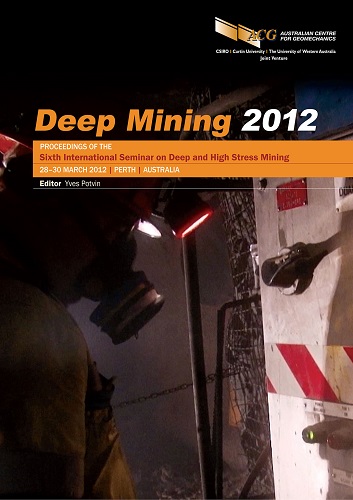Hydraulic fracturing for in situ stress measurements ‒ a simulation and experimental study

|
Authors: Rasouli, V Paper is not available for download Contact Us |
DOI https://doi.org/10.36487/ACG_rep/1201_17_rassouli
Cite As:
Rasouli, V 2012, 'Hydraulic fracturing for in situ stress measurements ‒ a simulation and experimental study', in Y Potvin (ed.), Deep Mining 2012: Proceedings of the Sixth International Seminar on Deep and High Stress Mining, Australian Centre for Geomechanics, Perth, pp. 239-245, https://doi.org/10.36487/ACG_rep/1201_17_rassouli
Abstract:
Hydraulic fracturing is a technique which has been used largely for estimating the subsurface stress state. This technique is best applicable in low permeable formations which are ideally homogeneous and continuum. Performing an in situ hydraulic fracture test, the induced fracture tends to propagate along the direction perpendicular to the direction of least resistance stress from the wellbore. However, the stress anisotropy ratio, as well as the existence of natural fracture planes, may deviate from the results that are expected, or may indeed mislead interpretation. This concept is discussed in this paper through the results of some 2D numerical simulations and lab experiments performed under true triaxial stress conditions. The stress cell, which is capable of applying three independent stresses on a cube of rock with different sizes, was used for the purpose of the experiments. The specifications of the equipment are also described briefly.
References:
Fairhurst, C. (1964) Measurement of in situ rock stresses, with particular reference to hydraulic fracturing, in Rock Mechanics and Engineering Geology, Vol. 2, pp. 129–147.
Hubbert, M.K. and Willis, D.G. (1957) Mechanics of hydraulic fracturing, Transactions of the American Institute of Mining, Metallurgical and Petroleum Engineers, Vol. 210, pp. 153–168.
Hudson, J.A. and Harrison, J.P. (1997) Engineering Rock Mechanics: an Introduction to the Principles, Oxford, Elsevier Science.
Iglauer, S., Wang, S. and Rasouli, V. (2011) Hydraulic fracturing induced by tri-axial stress fields measured via micro-computed tomography, Asia Pacific Oil and Gas Conference and Exhibition, 20–22 September 2011, Jakarta, Indonesia, SPE 145960.
Kim, K. and Franklin, J.A. (1987) Suggested methods for rock stress determination, International Journal of Rock Mechanics and Mining Sciences and Geomechanics Abstracts, Vol. 24 (1), pp. 53–74.
Rasouli, V. and Evans, J.B. (2010) A True Triaxial Stress Cell (TTSC) to simulate deep downhole drilling conditions, APPEA Journal 50, pp. 61–70.
Sarmadivaleh, M. and Rasouli, V. (2010) Studying the controlling parameters in Hydraulic Fracturing and fracture containment in tight formations, APPEA Journal 50, pp. 581–591.
Sarmadivaleh, M., Rasouli, V. and Nabipour, A. (2011a) A PFC2D Simulation of Hydraulic Fracture and Natural Interface Interaction, 2nd International FLAC/DEM Symposium, February 2011, Melbourne, Australia.
Sarmadivaleh, M., Rasouli, V. and Shihab, N.K. (2011b) Hydraulic fracturing in an unconventional naturally fractured reservoir: a numerical and experimental study, APPEA Journal 51, pp. 507–518.
© Copyright 2025, Australian Centre for Geomechanics (ACG), The University of Western Australia. All rights reserved.
View copyright/legal information
Please direct any queries or error reports to repository-acg@uwa.edu.au
View copyright/legal information
Please direct any queries or error reports to repository-acg@uwa.edu.au